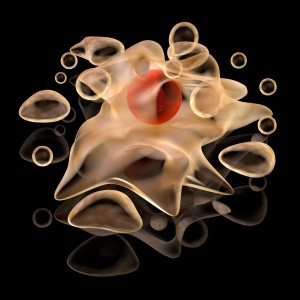 Breast cancer is a problem best solved by a multidisciplinary team. As such, a collaboration between biologists, physicists, and engineers at Georgetown Lombardi Comprehensive Cancer Center and Virginia Tech have embraced this fact to discover a new way to predict the outcome of antiestrogen therapy.
Breast cancer is a problem best solved by a multidisciplinary team. As such, a collaboration between biologists, physicists, and engineers at Georgetown Lombardi Comprehensive Cancer Center and Virginia Tech have embraced this fact to discover a new way to predict the outcome of antiestrogen therapy.
The team, led by Robert Clarke, PhD, DSc, of Georgetown, and William T. Baumann, PhD, of Virginia Tech, found a relationship between interferon regulatory factor-1 (IRF1) and autophagy regulator ATG7 that has implications in human breast cancer cell fate.
“We needed an engineering approach to a biological problem–no one had built a model like this before,” said Dr. Clarke in a news release from Georgetown. The group described a study designed to look at living cells from the perspective of an information processing system in their article, “Interferon Regulatory Factor-1 Signaling Regulates the Switch between Autophage and Apoptosis to Determine Breast Cancer Cell Fate,” published in Cancer Research.
The goal was to understand why approximately 125,000 estrogen-positive breast cancer patients may become resistant to tamoxifen, fulvestrant, and aromatase inhibitors, all of which are considered an antiestrogen therapy. This was a formidable goal, as explained by Dr. Baumann: “A cell is vastly harder to model than engineered systems, such as the nation’s electrical grid or a complex integrated circuit, because of the incredible number of interactions among its components. We are just at the beginning of being able to model an entire cell.”
Though only at the beginning of modelling cells, the team created a mathematical model from the foundation of all biological data known about estrogen-positive breast cancer. These data included information regarding tumor cell decisions and environmental signals that can lead to tumor cell survival.
Within the model, the team determined that IRF1 plays a key role in deciding whether a cell undergoes autophagy (a process whereby a cell rids toxic proteins to ensure survival) or apoptosis (programmed death). This molecule happens to jump into action upon stress in its environment, such as the presence of antiestrogen therapy.
[adrotate group=”3″]
Putting these findings into action, the team knocked out IRF1 and found an increase in resistance to antiestrogen therapy. They were able to reverse this behavior by silencing both ATG7 and IRF1. According to Dr. Clarke, none of these experiments would have came about if not for their model. “[Modeling] helps you find things that may be quite important that you would not have discovered using intuition alone,” he said. “The molecular logic of these circuits is difficult to comprehend by intuitive reasoning, and I know had we not had the model, we would have stopped our experiments before we discovered the importance of the IRF1 signal.”
Other contributing members included oncologists and geneticists from Georgetown and electrical engineers, computer engineers, and bioinformatics specialists from Virginia Tech. The work was funded by a $7.5 million grant from the federal government, with two Public Health Service Awards, a Susan G. Komen Grant, and an NIH training grant.

